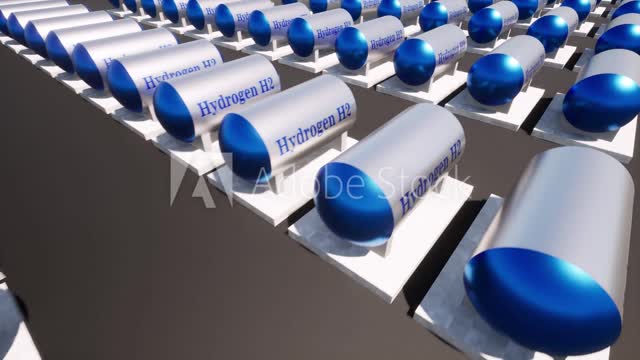Premium Only Content

Scientists successfully turned thin air into green hydrogen for 12 days
http://festyy.com/edJkyM
Scalable technology can work in relative humidity of four per cent too.
Hydrogen factory concept. Scharfsinn86/iStock
An international collaboration of researchers has successfully demonstrated the production of green hydrogen directly from the air, a press release said.
The breakthrough, published Tuesday in the journal Nature Communications, explains how researchers used renewable energy to split water molecules to create hydrogen. While the technique usually requires access to fresh water, the team was able to source water molecules from the air instead — greatly increasing the number of places that could produce the gas.
The findings could help with the global transition toward sustainable energy sources. Solar and wind installations are picking up steam as the world looks toward greener energy sources. Although energy is generated in an emission-free way in these methods, energy storage requires large batteries, which do not fit into the idea of sustainable living.
Last month, IE reported the grim side of lithium mining, as was revealed in pictures taken from the sky. Large stretches of salt flats in the Lithium Triangle of Argentina, Bolivia, and Chile are now covered with brine pumped to extract lithium, risking local flora, fauna, and communities.
The long-term solution to the problem may lie in other energy sources, such as hydrogen.
As green as it gets
Hydrogen combustion is possibly the cleanest of all energy resources we have on the planet. The fuel is relatively easy to transport and can be burnt anywhere to generate only water as the end product. Moreover, the water can be split back into hydrogen and oxygen using a renewable energy source to yield green hydrogen once again.
Scientists have been deploying water electrolyzers to split freshwater into a clean energy source, aiming to tie them up with renewable sources of power to make them greener and more sustainable. Unfortunately, there is a strong mismatch between the availability of freshwater and renewable energy sources.
Water is scarce even to meet local needs in regions where wind and solar are abundant. Renewables are scarce in areas with plenty of fresh water to make hydrogen fuel. at is precisely where the problem lies.
There is a strong mismatch between the availability of freshwater and renewable energy sources. Water is scarce even to meet local needs in regions where wind and solar are abundant. Renewables are scarce in areas with plenty of fresh water to make hydrogen fuel.
Tapping into the air's moisture
IE has previously reported how researchers want to tap into the moisture content in the air to solve water woes. A research collaboration of scientists from China, Australia, and the U.K. wants to take this a step forward and harvest green hydrogen from the system.
The researchers use a hygroscopic electrolyte to absorb the moisture from the air and then power the electrolysis using energy harnessed from the sun or wind. Their current density with their setup was 574mA per sq. cm. The prototype was operated consecutively for 12 days, during which the Faradaic efficiency was stable at 95 per cent, the researchers said in a paper published today.
The researchers also tested their prototype in dry regions with a relative humidity of four per cent and found that it performed satisfactorily in bone-dry environments.
About us https://bit.ly/3GUPFOa
Contact us +919942258153 [email protected]
Thank You Very Much for Sharing YourValuable Thoughts
https://35f20h3hwa86g5g9sd27m6wcbu.hop.clickbank.net
-
 LIVE
LIVE
The Chris Salcedo Show
11 hours agoReckoning on Injustices Perpetrated Against Americans
408 watching -
 LIVE
LIVE
LFA TV
12 hours agoLIVE & BREAKING NEWS! | FRIDAY 10/17/25
2,759 watching -
 LIVE
LIVE
Game On!
18 hours agoAnother Football Friday! BEST BETS For The Weekend!
1,048 watching -
 14:23
14:23
Tactical Considerations
15 hours ago $2.84 earned5 Budget Pistols I would Actually Carry Under $425
11.5K1 -
 15:24
15:24
ArynneWexler
18 hours ago"I'm the Mayor Now" Somalian Midwest Takeover | NN Clip
2.41K18 -
 14:49
14:49
Esports Awards
18 hours agoEsports Awards 2025 Finalist Reveal
3.84K -
 LIVE
LIVE
BEK TV
23 hours agoTrent Loos in the Morning - 10/17/2025
118 watching -
 53:31
53:31
Daniel Davis Deep Dive
16 hours agoU.S. War Dept v. Russia /Larry Johnson & Lt Col Daniel Davis
3.9K7 -
 3:40
3:40
NAG Daily
14 hours agoHOW TO NEVER BE WRONG AGAIN (A COMPLETE GUIDE W/GreenMan Reports)
3.06K -
 9:21
9:21
Dr Disrespect
20 hours agoMOST INSANE 110 ASSIST Game in Battlefield 6
125K7